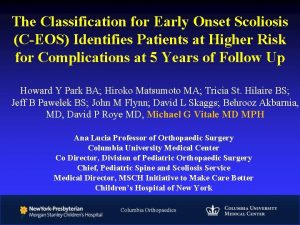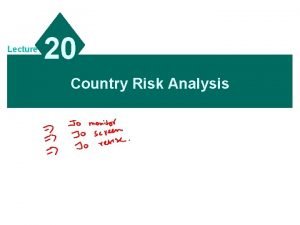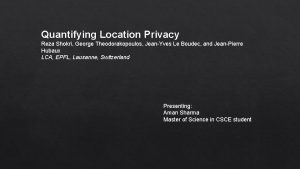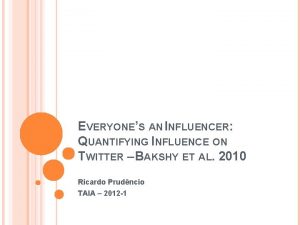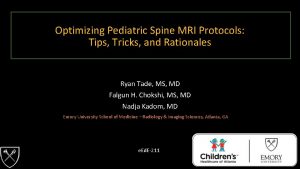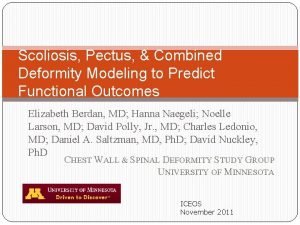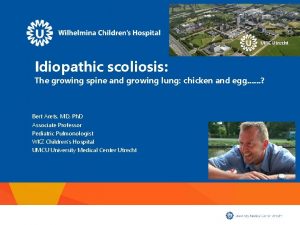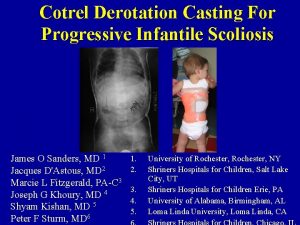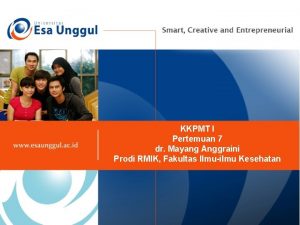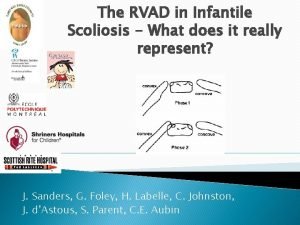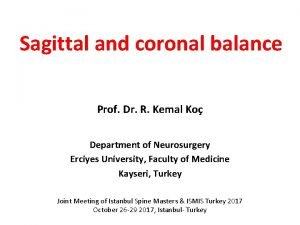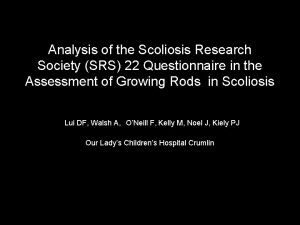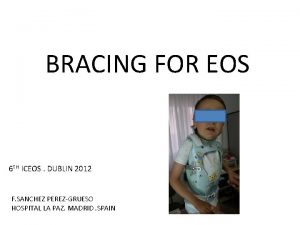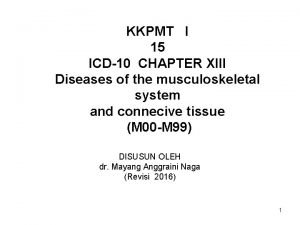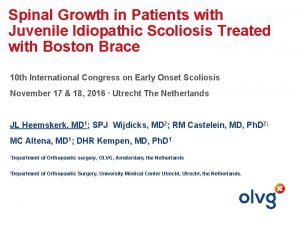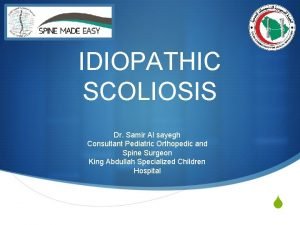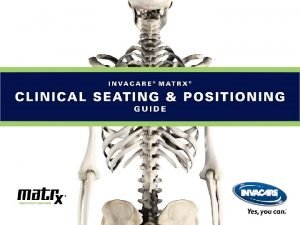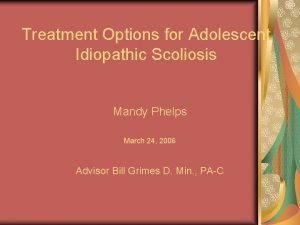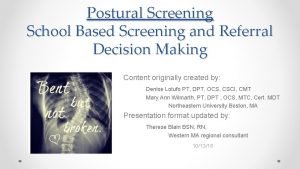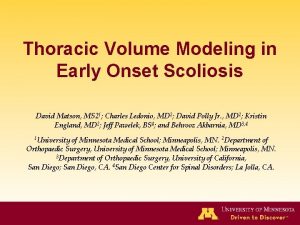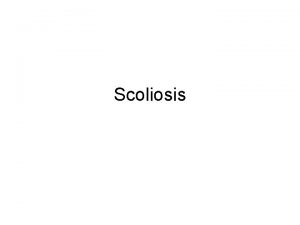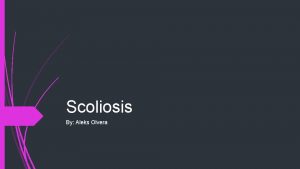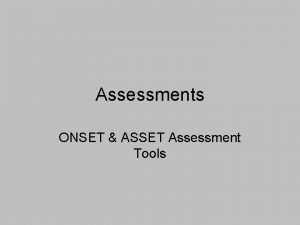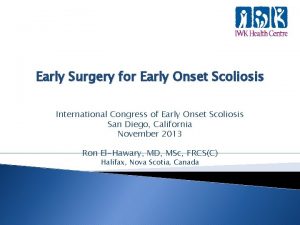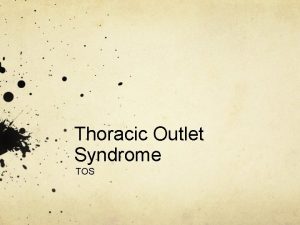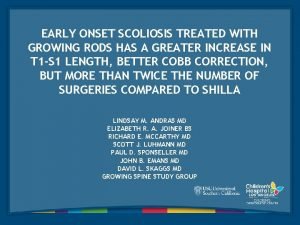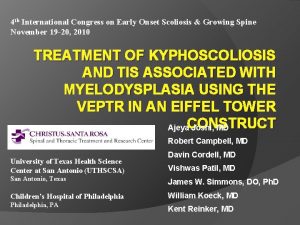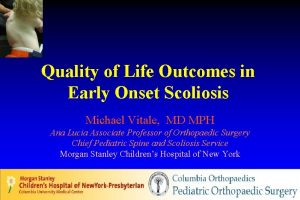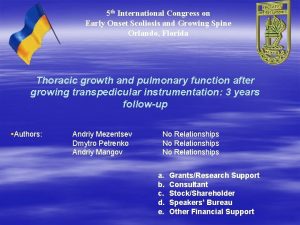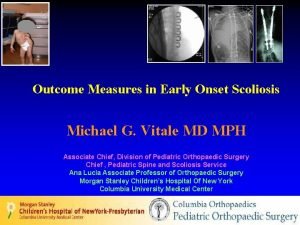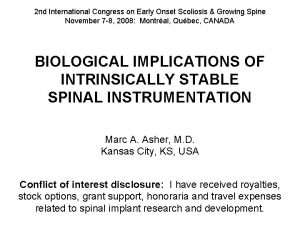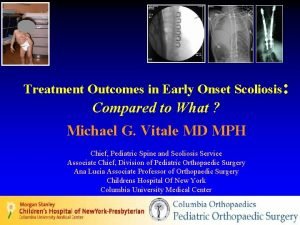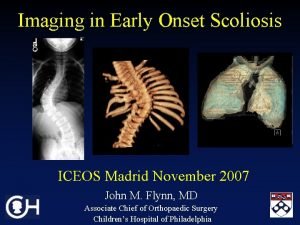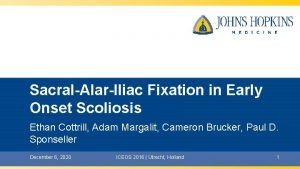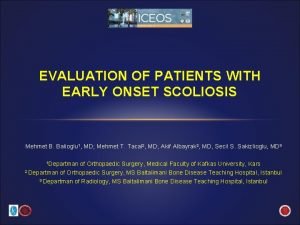Quantifying the Thoracic Deformity in Early Onset Scoliosis





















- Slides: 21

Quantifying the Thoracic Deformity in Early. Onset Scoliosis – The Spinal Penetration Index Ryan Muchow, MD Charles Johnston, MD* Anna Mc. Clung, BSN, RN Richard Browne, Ph. D * Medtronic a, e

Dubousset 2002 – Penetration Index • Described by Dubousset in 2002, and termed ‘Spinal Penetration Index, ’ as an apical rotation and lateral displacement of the spine into the convex hemithorax • Subjective - Unable to quantify

‘The Spinal Penetration Index’ • Penetration of spine into convex hemithorax – ratio = apical vertebral translation • Anterior – posterior dimensions of the concave and convex hemithoraces • Apical vertebral rotation

SPI: 1) CVXw / CAVw 2) 3) 4) CAVw T 10 CVXw

SPI: 1) 2) ANT / POSTCVX 3) 4) ANT POSTCVX T 10

SPI: 1) 2) 3) ANT / POSTCAV 4) ANT POSTCAV T 10

SPI: 1) CVXw / CAVw 2) ANT / POSTCVX 3) ANT / POSTCAV 4) Apical rotation ANT CAVw CVXw POSTCAV T 10 POSTCVX

SPI: 1) CVXw / CAVw = 1 2) ANT / POSTCVX 3) ANT / POSTCAV 4) AVR = 0 ANT CAVw POSTCAV T 10 CVXw POSTCVX

Methods – Study Population IRB-registered database of EOS patients 98 patients 138 Chest CTs (lung volumes) Congenital – 19 IIS – 31 Syndromic – 88

Methods – Control Population IRB-registered database at Children’s Medical Center 40 Normal Patients (eg. Trauma, malignancy, etc. ) SPI measured at T 4, T 6, T 8, and T 10

Results – Normal Values NORMAL (40) CVXw / CAVW ANT / POSTCAV ANT / POSTCVX Apical Rotation T 4 0. 97 (0. 83 - 1. 09) 1. 7 (0. 9 - 3. 1) 1. 7 (1. 0 - 2. 7) - T 6 0. 98 (0. 88 - 1. 12) 2. 2 (1. 5 - 3. 5) 2. 2 (1. 6 - 3. 5) - T 8 0. 97 (0. 87 - 1. 08) 2. 4 (1. 7 - 3. 4) 2. 3 (1. 7 - 3. 5) - T 10 0. 98 (0. 85 - 1. 09) 2. 5 (1. 6 - 4. 5) 2. 4 (1. 7 - 3. 8) - <10%* >10% - Coef. of variation T 4 T 6 T 8 T 10

Results EOS CVXw / CAVW ANT / POSTCAV ANT / POSTCVX Apical Rotation Cobb ≤ 30 0. 53 (0. 17 - 0. 68) 2. 1 (0. 9 - 3. 3) 2. 2 (1. 2 - 5. 5) 13. 5 (1 - 32) Cobb > 30 0. 44 (0. 06 - 0. 94) 3. 5 (1. 1 - 18. 5) 2. 8 (1. 0 - 16. 8) 30. 4 (8 - 77) 0. 034* <0. 0001* 0. 098 <0. 0001* p-value Cobb angle Cvx/Cav ratio Ant/Post ratios (2 o lordosis ? )

Surgical correction -> effect on SPI (proposed) CVXw/CAVw increasing toward 1 • A/PCAV decreasing • A/PCVX decreasing • Apical rotation decreasing •

Results – Effect of Surgery on SPI (n=20) EOS CVXW / CAVW ANT / POSTCAV ANT / POSTCVX Apical Rotation Pre-Op (20) 0. 32 (0. 06 - 0. 59) 4. 5 (1. 2 - 18. 5) 3. 5 (1. 5 - 16. 8) 39. 4 (10 - 77) Post-Op (20) 0. 35 (0. 11 - 0. 72) 4. 4 (1. 2 - 13. 1) 3. 0 (1. 3 - 10. 4) 40. 7 (2 - 67) 0. 997 0. 687 0. 425 0. 585 p-value Surgery -> No effect on SPI (entire group)

Effect of different constructs on SPI change postop Cvx/Cav A/P cvx A/P cav Apex rot Spine-spine n=6 No change Spine-rib n=9 No change Spine-spine w/apical cntrl n=5 . 42 ->. 65 3. 88 -> 2. 57 3. 11 -> 3. 52 39 o -> 35 o

T 10 Patient #2 NL CVXW / CAVW ANT / POSTCVX ANT / POSTCAV 13. 0 / 81. 5 = 0. 16 97. 2 / 12. 74 = 7. 6 97. 2 / 7. 4 = 13. 1 0. 98 2. 44 2. 54 105 o 97. 2 13. 0 12. 74 81. 5 7. 4 72 o

T 10 CVXW / CAVW ANT / POSTCVX ANT / POSTCAV Patient #2 – Pre. Op 13. 0 / 81. 5 = 0. 16 97. 2 / 12. 74 = 7. 6 62. 7 / 7. 4 = 13. 1 Patient #2 - Post. Op 21. 47 / 92. 0 = 0. 23 109. 1 / 23. 23 = 4. 7 109. 1 / 9. 6 = 11. 3 0. 98 2. 44 2. 54 NL 109. 1 AVR pre 72 o post 67 o 2 o Pure distraction 21. 47 92. 0 9. 6 23. 23 67 o

Serial lengthening + apical translation correction 4 yr postop

Preop Followup SPI =. 63 A/Pcav =3. 1 A/Pcvx=2. 6 AVR=25 o SPI = Cvx/Cav =. 32 A/Pcav =89/17. 8 =5 A/Pcvx=88. 9/27. 8=3. 2 AVR=43 o

Discussion 1. Quantifies endothoracic deformity in 3 planes 2. Better characterization of correction achieved Limitations 1. Small # pre-/postop patients 2. Significant variation A/P plane in normals 3. Requires CT scan

Thank you
 Early onset scoliosis classification
Early onset scoliosis classification When quantifying country risk:
When quantifying country risk: Quantifying uncountable nouns
Quantifying uncountable nouns Quantifying credit risk
Quantifying credit risk George theodorakopoulos
George theodorakopoulos Everyone's an influencer: quantifying influence on twitter
Everyone's an influencer: quantifying influence on twitter Mri scoliosis protocol
Mri scoliosis protocol Rib hump scoliosis
Rib hump scoliosis Scoliosis
Scoliosis Risser cast scoliosis
Risser cast scoliosis Thoracogenic scoliosis of thoracolumbar region
Thoracogenic scoliosis of thoracolumbar region Rvad
Rvad Coronal balance scoliosis
Coronal balance scoliosis Scoliosis research society
Scoliosis research society X iceos
X iceos Infantile scoliosis casting
Infantile scoliosis casting Thoracogenic scoliosis of thoracolumbar region
Thoracogenic scoliosis of thoracolumbar region Scoliosis chiropractor seminole county
Scoliosis chiropractor seminole county Scoliosis advisor
Scoliosis advisor Hyperextesion
Hyperextesion Scoliosis advisor
Scoliosis advisor Risser sign
Risser sign
